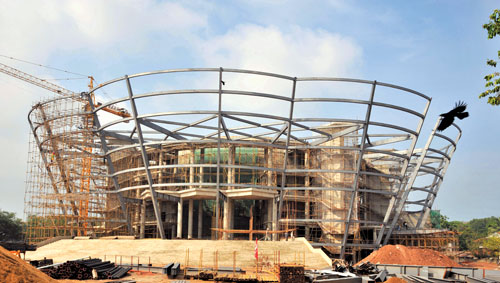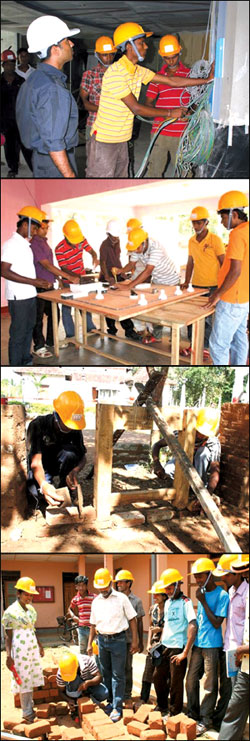ReviewSteady growth in
construction industry
Ramani KANGARAARACHCHI
The construction industry has recorded a growth of 9.3 percent
alongside Sri Lanka's economic growth of 8 percent in 2010.
The value of the construction industry in 2010 was in the region of
Rs four hundred twenty thousand million (Rs 423,414 Mn.) or in terms of
USD three thousand nine hundred million (US$ 3,849 Mn) at current
prices.
|

The Mahinda Rajapaksa Nelum Pokuna Performing Arts Centre at the
time of construction. |
The construction industry as it stands today accounts for 7.2 percent
of the total work force in the country which amounts to around 570,000
persons.
With the industry very largely being an informal sector employing
casual labour for multiple reasons, heavily relying on labour
contractors and sub contractors, the recorded statistics of employment
are heavily under stated.
Construction industry's contribution to gross domestic fixed capital
formation has been in the region of 69 to 70 percent during the period
2009 and 10.
With Sri Lanka aiming for an average GDP growth of 8.0 percent in the
medium to long-term, a significant amount of investment is expected to
come under the construction sector.
The construction industry has recorded a phenomenal growth of 14.3
percent in the first quarter of 2011 as against 8.5 percent in the
corresponding period of 2010. According to the latest quarterly estimate
of the Census and Statistics Department for the third quarter of 2011
the growth of the industry has been noted as 17.3 percent which is the
highest ever recorded quarterly growth.
This is compared to a growth level of 11.3 percent for the third
quarter of 2010.
Growth in the construction industry has been the largest due to
unprecedented infrastructure development programmes, housing and post
conflict reconstruction taking place in the north and east.
The growth momentum in the industry is also reflected in the
consumption of cement and has been rising in the recent past. Look at
the overall cement market in Sri Lanka.
|

Construction workers at a site |
The market size estimated for year 2009 was around 3.1 million tons
which has been enhanced to around 3.7 million in 2010.
This will definitely exceed 4.2 million tons for the year 2011 in the
estimation.
Notwithstanding the high priority attached to HRD the investment in
the training of construction craft persons and middle level technicians
appeared to be grossly inadequate.
Demand for Sri Lankan construction labour in the overseas market is
among the highest.
Statistics published by the SLFEB in 2010 show that the largest
demand is for masons. Then electricians, plumbers, carpenters, welders
are among the most sought after skills for foreign employment
placements.
A large number of job orders received for craft and related
occupations remain unfilled.
At the end of the year 2010 almost 30,000 job orders had been
received from foreign principals with the demand for masons alone being
nearly 7,500.
There is no doubt that Sri Lanka will experience a large scale
capacity shortfall in the industry which if not immediately fulfilled
will adversely affect the development programmes and overall national
economic growth.
Unfortunately vocational training in Sri Lanka in the past has not
been market driven. Sri Lanka has a national vocational qualification
framework with opportunities for career advancement particularly in the
construction sector.
There has been a steady increase in the number of young people and
school leavers joining the construction industry.
Today less than 10 percent of the industry workforce is accredited
with the balance not having undergone formal training. Low productivity,
poor quality of construction, implementation delays and cost overruns
are the consequential effects of not having an accredited construction
work force in Sri Lanka.
It is heartening to note that even multilateral development banks
such as ADB have identified the need for training and generous
provisions have been made for training of craft persons.
A number of bilateral donors have also funded projects for livelihood
development of conflict affected persons in the north and east region in
particular.
However, in the undertaking of construction craftsman training is
that vocational training in the country must be carried out in terms of
NVQ framework.
The tertiary and vocational education commission has come out with a
system to ensure high quality training with approval of training centres
after physical inspection and accreditation of courses to ensure that
course planning, monitoring of courses and delivery are all in place.
They have introduced a well designed and accomplished curricular that
needs to be followed, and a sound competency assessment system for
students to receive NVQ accreditation.
Authorities at provincial and district level and even at lower levels
must ensure that there are no fly by night operators undertaking
vocational training in the country.
Nobody should be allowed to promote vocational training without the
necessary approvals, registration and supervision of TVEC and outside
the NVQ framework.
Construction craftsman training could be provided within a short
period of six months to those with least educational qualifications.
Included in this six month training programme is 2 to 3 months of on
the job training during which trainees are adequately compensated being
at least paid a living allowance.
For those with least educational qualifications from the most
vulnerable sectors of society, training in construction craft provides
an opportunity to obtain gainful employment in the shortest possible
span of time.
For those who have been deprived of opportunities to enter
universities and technical colleges to become professional engineers or
technical officers, the NVQ framework is the only way forward to achieve
such professional qualifications while also being employed.
Another challenge in the construction industry is its inability to
adopt new technologies. Construction industry has been more or less a
family based business sector.
This is reflected in the reluctance of construction companies to
enter the capital market. It is not possible to find construction
companies in the stock market.
Industry regulators must insist that a large percentage of the
construction workforce should be accredited.
Obtaining a CSE listing must be made criteria for higher grading of
construction contractors. This will enable the industry to become more
professional.
Maintenance of quality management systems should be made compulsory.
The business philosophy of the construction industry must be quality. If
the workforce is given better conditions of work and social benefits,
and occupational health and safety standards are adhered to, the
industry will be able to attract more young people. In the long-term it
will be more beneficial to both the client and the contractor.
The construction industry should also look at markets beyond the
boundaries of island's nation. There are enough markets in the Southern
African region while continuous growth is being recorded by the
construction industry in the Gulf region - Qatar, Oman.
If Sri Lankan contractors and consultants are deployed on local
projects on a preferential basis and overseas collaborations are
specifically identified and encouraged, the industry could become export
ready in the immediate future.
Action must also be taken to find a lasting solution for the shortage
of critical construction material. Consequent to the incentives given
for strategic import replacement enterprises, a number of investments
are expected to be made in the cement sector.
With domestic cement production traditionally accounting for 2/3 of
the domestic market, the country has been importing more than 1/3 of its
demand. With an enhanced market as one could see from the phenomenal
growth it is recording from 3.1 million metric tonnes in 2009 to 4.2
million or more in 2011, the demand for imported material will become
larger.
This will result in the importation of sub quality cement and create
a series of problems. Therefore government has taken a significant step
by allowing generous incentives while facilitating a concessionary tax
structure for those who are investing in the cement manufacturing
sector.
Unfortunately Sri Lanka has not been able to find a durable and
environment friendly solution to the shortage of sand for construction
purposes.
There is no justification to allow unrestricted river sand mining in
the country.
The ill-effects of river sand mining have been well evident and
recorded. Present shortage of sand will enhance the cost of construction
with a cube of river sand having already reached Rs 9 to 10 thousand in
the recent past.
The Chamber of Construction Industry CEO Dakshitha Talgodapitiya has
advocated offshore sand mining as the only durable, cost effective and
environment friendly alternative to mitigate the shortage of river sand.
The chamber did attempt to deploy international dredging contractors
to obtain offshore sand from time to time.
Offshore sand without being subjected to washing would have had
disastrous consequences.
Ad-hoc deployment of dredging contractors is not the solution. It
cannot be pursued as a durable and long-term solution.
A lesson from the Indian experience should be taken where a
government owned specialized dredging company in collaboration with an
International dredging company was established.
Government ownership is a necessity since this involves exploitation
of natural resources, the need to maintain environmental standards,
proper identification of burrow areas, areas for shock piling and proper
drainage of the area to eliminate salinity.
There have been instances of many disputes arising from measuring
mechanisms of stocks. Dredgers particularly ocean going suction dredgers
are high value equipment. Pipe laying, installation of boosters, pumping
all involve high technology and expertise in handling. Cost of
mobilization and demobilization are very high.
Therefore for continuous offshore mining for construction purposes
and other reclamation purposes it is necessary to look at installing
national dredging capacities in the country.
When the Sri Jayawardenapura Parliament complex was constructed,
inland dredging for reclamation purposes was introduced in 1979 and
today that technology has come to stay in Sri Lanka. If construction can
be made more like a production process creating a factory environment
with a competent workforce and cost effective and environment friendly
material, Sri Lanka could be made the wonder of Asia.
Construction is the driver of development. The country needs to look
at development benefiting the people. Achievement of the holistic goals
of inclusive development and participation of the beneficiary
communities could be made a reality. The vehicle to travel this path is
the construction industry.
(We thank the Chamber of Construction Industry and former CEO
Dakshitha Thalgodapitiya who was CEO and Secretary General of the
Chamber of Construction Industry for providing information for this
article. He will continue to be associated with the Chamber as the
Senior Advisor handling donor funded projects, special projects and
international relations.) |



